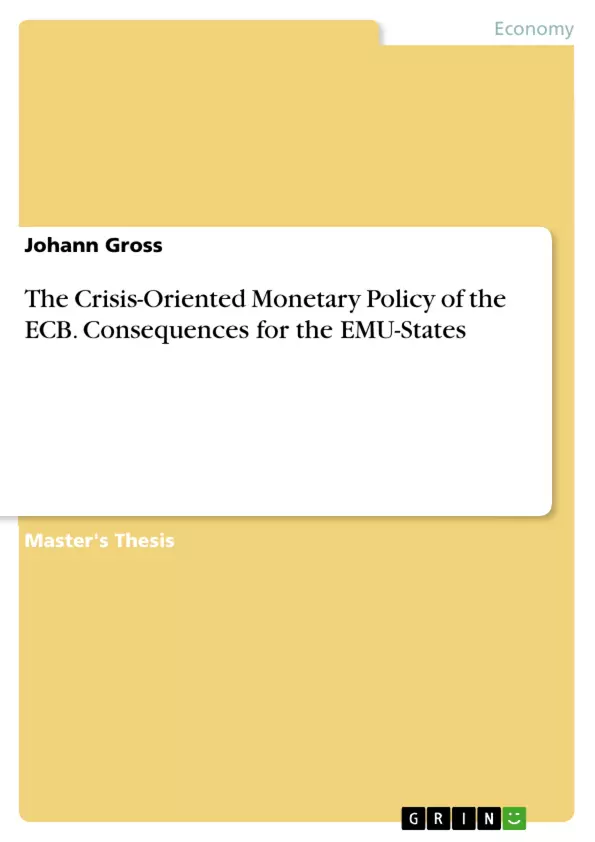With the launch of the Eurozone as a monetary union and the EU as a supranational amalgamation of sovereign countries, the European debt crisis tangents nearly all member states and does not limit itself to several countries. Exactly here the shoe pinches, as former national problems transferred into international challenges with economic and social costs for a higher group of states which have to bear the consequences. The first problem is, that the stability-oriented monetary policy of the ECB turned into crisis-oriented operations and unconventional monetary decisions which potentially will convert in real consequences for the EMU states and cause economic costs. Second, the European debt crisis is not solved by bailing out countries like the PIIGS states, as governments still increase their public debts, the EU and its institutions only achieve a suspension of the problem but does not resolve it by the roots. Most of the so called PIIGS states, did not use the low-interest period to remove the debt level and to reform their economic structure for a higher economic competitiveness which would have an effect on the GDP. Rather, some states increased their public debts and had a decrease in the GDP, which definitely turns into a grave situation.
Inhaltsverzeichnis (Table of Contents)
- Introduction
- Problem Definition
- Objectives
- Methodology
- The European System of Central Banks
- History and Development
- Organizational Structure, and Objectives of the E(S)CB
- Strategy and Instruments of Monetary Control
- Genesis and Causes of the European Debt Crisis
- Massive Consume and Increase of Public Debts after the Euro Implementation
- Productivity Deadlock and Increase in Labor Cost
- Misgovernment
- Global Financial Crisis 2007 et seqq.
- Conclusion
- Unconventional Monetary Operations of the ECB
- General Monetary Operations
- Securities Markets Program
- Outright Monetary Transactions
- Extended Asset Purchase Program
- Conclusion
- Impact of the Unconventional Monetary Operations of the ECB
- Inflation Rate (Price Stability)
- Confidence in Financial Markets
- Risk Premiums and Yields of Government Bonds
- Fiscal Situation of the PIIGS States
- Conclusion
- Consequences of the Crisis-Oriented Monetary Policy
- Transfer of Capital Liabilities to other EMU Members
- Moral Hazard
- Loss of Market Economy and Democracy
- Deadweight Loss
- Conclusion
- Conclusion
- Discussion
Zielsetzung und Themenschwerpunkte (Objectives and Key Themes)
This work aims to analyze the unconventional monetary policy of the European Central Bank (ECB) in the context of the European debt crisis. It examines the background of the crisis, the ECB's response through unconventional monetary operations, and the impact of these measures on various economic factors.
- The European debt crisis and its causes
- The role of the European System of Central Banks (ESCB)
- Unconventional monetary operations of the ECB
- The impact of the ECB's monetary policy on economic indicators
- The consequences of crisis-oriented monetary policy
Zusammenfassung der Kapitel (Chapter Summaries)
The first chapters introduce the European debt crisis, setting the stage for the analysis of the ECB's response. It explores the historical development of the ESCB, its organizational structure, and its monetary control strategies. This is followed by a detailed examination of the roots of the European debt crisis, considering factors such as excessive public debt accumulation, productivity stagnation, misgovernance, and the global financial crisis. The subsequent chapters delve into the ECB's unconventional monetary operations, including the Securities Market Program, Outright Monetary Transactions, and the Extended Asset Purchase Program. These chapters analyze the effectiveness of these measures in achieving price stability, boosting confidence in financial markets, and managing government bond yields. The final chapters before the conclusion explore the consequences of the ECB's crisis-oriented monetary policy. They examine the transfer of capital liabilities, the potential for moral hazard, the potential erosion of market economy principles, and the emergence of deadweight loss due to the ECB's interventions.
Schlüsselwörter (Keywords)
The text focuses on the European debt crisis, unconventional monetary policy, the European Central Bank (ECB), the European System of Central Banks (ESCB), price stability, financial market confidence, government bond yields, moral hazard, deadweight loss, and the impact of crisis-oriented monetary policy on economic indicators.
- Quote paper
- Diplom-Kaufmann (FH) Johann Gross (Author), 2015, The Crisis-Oriented Monetary Policy of the ECB. Consequences for the EMU-States, Munich, GRIN Verlag, https://www.grin.com/document/351077



